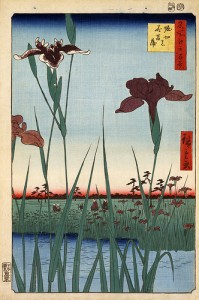Almost half the expensive rose oil used in perfumes and cosmetics comes from a single valley in Bulgaria.
Let the BBC tell you all about it.
Agricultural Biodiversity Weblog
Agrobiodiversity is crops, livestock, foodways, microbes, pollinators, wild relatives …
Almost half the expensive rose oil used in perfumes and cosmetics comes from a single valley in Bulgaria.
Let the BBC tell you all about it.
We went to the Hirishoge exhibition here in Rome some time ago, and very impressive it was too, but I don’t remember seeing this particular woodcut.

I’ve in fact only just come across it, on Flickr, where there is this fascinating commentary:
In the village of Horikiri in suburban Edo, gardeners grew a year-round variety of flowers and were particularly famous for the iris shown here, “hanashobu,” well suited to this swampy land. In this print Hiroshige has shown three, almost-life-size, detailed specimens of the nineteenth-century hanashobu hybrids and in the distance, sightseers from Edo are admiring the blossoms. In the 1870’s the cultivation of hanashobu had begun to spread rapidly in Europe and America and the developed into a booming export market for the gardeners of Horikiri. The Horikiri plantations began to wane in the 1920’s and eventually turned over to wartime food production. After the war, one of them was revived and is now a public park, particularly popular in May when the flowers are in bloom.
The report in FoodNavigator seemed pretty boring at first sight:
EcoFlora has developed a natural, acid-stable blue coloring for foods, beverages and cosmetics and it says the creation of a sustainable supply chain differentiates it from other colors on the market.
But then I googled the plant involved (“edible jagua fruit, which grows in the Chocó rainforest” of Colombia). It turns out jagua is Genipa americana, which is cultivated for its edible fruit, but also has other traditional uses.
South American Indians bathe their legs in the clear liquid obtained from the fruit. The liquid has an astringent effect. When the liquid oxidizes, it stains the skin black. These stains are permanent, but only color the top few layers of skin, and thus disappear after about a fortnight, when the skin is naturally shed. As South Americans Indians went into battle, they used to paint themselves with Genipa juice and annatto.
The active compound is called genipin. Apparently, there’s been a “recent explosion in the popularity of Jagua body art.”
There’s nothing in the FoodNavigator piece about where the idea for this “natural, acid-stable blue coloring for foods, beverages and cosmetics” ultimately came from. However…
EcoFlora says it is committed to working with some of the poorest communities in the region to harvest the fruit in a manner which is environmentally sustainable and beneficial to the local economy.
Well, that’s something, I suppose.
The FreshPlaza newsletter is a veritable treasure trove of information on fruit & veg around the world. Yesterday’s issue was particularly rich in agrobiodiversity articles. Among other things, it pointed to pieces about how the British are losing their cherry varieties, and about how a Washington State farmer found a new one. There was also an appreciation from Pakistan of the local fruit known as “jamun“, which is probably Syzygium cumini.